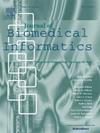一种新的基于机器学习的工作流程,通过转录多标签表征和临床相关分类来捕获患者内部异质性
IF 4.5
2区 医学
Q2 COMPUTER SCIENCE, INTERDISCIPLINARY APPLICATIONS
引用次数: 0
摘要
目的:在面对复杂、异质性疾病的生物医学研究和临床实践中,将患者分为特定的分子亚型是至关重要的。现有的方法,特别是基于基因表达的癌症亚型,往往简化了患者的分子图谱,忽视了多个亚型特征的潜在共现性。然而,认识到样本内异质性对于更精确的患者特征和改进个性化治疗至关重要。方法:我们开发了一种新的计算工作流程,名为MULTI-STAR,它解决了目前的局限性,并为可靠的多标签患者亚型提供了量身定制的解决方案。MULTI-STAR使用最先进的亚型方法来获得有前途的基于机器学习的多标签分类器,利用基因表达谱。它修改了标准的单标签基于相似性的技术,以获得多标签的患者特征。然后,它利用这些特征来训练使用不同多标签策略的单样本预测器,并找到性能最好的分类器。结果:MULTI-STAR分类器提供了对患者分子和临床特征相关的所有亚型的先进的多标签识别,也区分了主要亚型和其他相关的次要亚型。通过开发用于乳腺癌和结直肠癌亚型的多标签解决方案证明了其有效性,该解决方案在预后价值方面优于现有方法,主要用于总体生存预测,并且能够根据临床实践的需要一次处理单个样本。结论:这项工作强调了转移到多标签亚型以捕获单个患者的所有分子特征的重要性,同时考虑了以前被忽视的次要分配,并为改善不同异质性疾病背景下的临床决策过程铺平了道路。事实上,MULTI-STAR新颖、可重复和可推广的方法提供了患者内部异质性的全面表征和临床相关见解,有助于精准医学和个性化治疗。本文章由计算机程序翻译,如有差异,请以英文原文为准。

A novel machine learning-based workflow to capture intra-patient heterogeneity through transcriptional multi-label characterization and clinically relevant classification
Objectives:
Patient classification into specific molecular subtypes is paramount in biomedical research and clinical practice to face complex, heterogeneous diseases. Existing methods, especially for gene expression-based cancer subtyping, often simplify patient molecular portraits, neglecting the potential co-occurrence of traits from multiple subtypes. Yet, recognizing intra-sample heterogeneity is essential for more precise patient characterization and improved personalized treatments.
Methods:
We developed a novel computational workflow, named MULTI-STAR, which addresses current limitations and provides tailored solutions for reliable multi-label patient subtyping. MULTI-STAR uses state-of-the-art subtyping methods to obtain promising machine learning-based multi-label classifiers, leveraging gene expression profiles. It modifies standard single-label similarity-based techniques to obtain multi-label patient characterizations. Then, it employs these characterizations to train single-sample predictors using different multi-label strategies and find the best-performing classifiers.
Results:
MULTI-STAR classifiers offer advanced multi-label recognition of all the subtypes contributing to the molecular and clinical traits of a patient, also distinguishing the primary from the additional relevant secondary subtype(s). The efficacy was demonstrated by developing multi-label solutions for breast and colorectal cancer subtyping that outperform existing methods in terms of prognostic value, primarily for overall survival predictions, and ability to work on a single sample at a time, as required in clinical practice.
Conclusions:
This work emphasizes the importance of moving to multi-label subtyping to capture all the molecular traits of individual patients, considering also previously overlooked secondary assignments and paving the way for improved clinical decision-making processes in diverse heterogeneous disease contexts. Indeed, MULTI-STAR novel, reproducible and generalizable approach provides comprehensive representations of patient inner heterogeneity and clinically relevant insights, contributing to precision medicine and personalized treatments.
求助全文
通过发布文献求助,成功后即可免费获取论文全文。
去求助
来源期刊

Journal of Biomedical Informatics
医学-计算机:跨学科应用
CiteScore
8.90
自引率
6.70%
发文量
243
审稿时长
32 days
期刊介绍:
The Journal of Biomedical Informatics reflects a commitment to high-quality original research papers, reviews, and commentaries in the area of biomedical informatics methodology. Although we publish articles motivated by applications in the biomedical sciences (for example, clinical medicine, health care, population health, and translational bioinformatics), the journal emphasizes reports of new methodologies and techniques that have general applicability and that form the basis for the evolving science of biomedical informatics. Articles on medical devices; evaluations of implemented systems (including clinical trials of information technologies); or papers that provide insight into a biological process, a specific disease, or treatment options would generally be more suitable for publication in other venues. Papers on applications of signal processing and image analysis are often more suitable for biomedical engineering journals or other informatics journals, although we do publish papers that emphasize the information management and knowledge representation/modeling issues that arise in the storage and use of biological signals and images. System descriptions are welcome if they illustrate and substantiate the underlying methodology that is the principal focus of the report and an effort is made to address the generalizability and/or range of application of that methodology. Note also that, given the international nature of JBI, papers that deal with specific languages other than English, or with country-specific health systems or approaches, are acceptable for JBI only if they offer generalizable lessons that are relevant to the broad JBI readership, regardless of their country, language, culture, or health system.
 求助内容:
求助内容: 应助结果提醒方式:
应助结果提醒方式:


